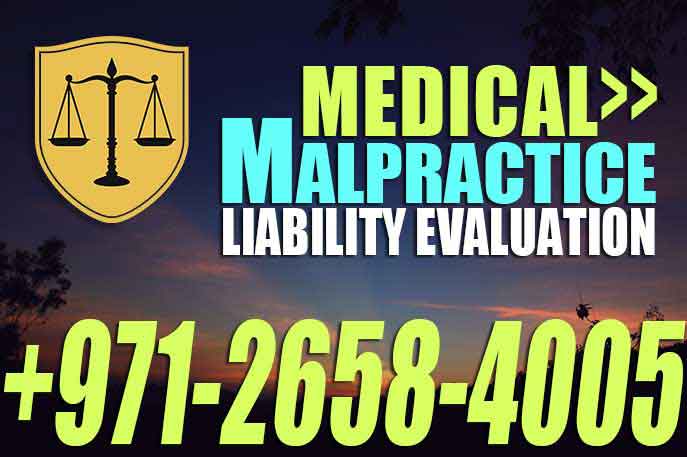
Medical Malpractice Liability Evaluation – UAE Law
Medical Malpractice Liability Evaluation – UAE Medical responsibility and liability lawsuits have become a fact of life in every physician’s modern practice WhatsApp: +971555570005
Medical Malpractice Liability Evaluation
Medical Malpractice Liability Evaluation
Medical responsibility and liability lawsuits have become a fact of life in every physician’s modern practice, complicated by factors beyond the traditional realm of patient care, including novel technologies which involve economic pressures, loss of physician autonomy and increasingly defensive medicine.
The role of Legal Medicine has become increasingly specific, essential and ineluctable in the judicial setting in order to prevent and avoid erroneous interpretations and hasty scientific verdicts. The multiplicity of regulatory frameworks and operative systems and the literature on medical malpractice, as well as a recent exploratory supranational survey, prove the absence of international medico-legal guidelines and/or recommendations governing the ascertainment and evaluation process in cases of suspected medical liability.
Evaluation Steps:
1. Comparative evaluation of data: The medico-legal expert gathers together all the data from the various ascertainment phases, conducts an initial synthesis according to conceptual area and reaches a comparative final evaluation.
2. Identification of pathological features: the physiopathological pathways revealing the chain of events must be identified and clearly described.
3. Damage identification: This covers possible damage or incapacity, either temporary or permanent.
4. Reconstruction of physiopathological pathways and ideal medical conduct: It is essential to consult only scientific sources, which predate or are contemporary with the facts, accredited by the referenced scientific associations or institutions of the competent disciplines.
5. Reconstruction of the real medical conduct: the medico-legal expert must establish whether there are sufficient data to proceed to the reconstruction and ascertainment of the conduct of medical and healthcare personnel.
6. Reconstruction and verification of real conduct of medical and healthcare personnel: The first stage consists of applying the extrapolation method to data, which are significant and useful for reconstructing and ascertaining the conduct of medical and healthcare personnel. The medico-legal expert must then reconstruct and analyze ex-post the conduct of medical and healthcare personnel and adequacy of treatment and care.
7. Identification of error/non-observance: In order to identify possible error and/or non-observance of required rules of conduct, the present consensus document proposes the following definitions.
8. Classification of error/non-observance: The comparative evaluation between ideal conduct as resumed from scientific sources and real conduct reveals evidence of error(s) or non-observance of required rules of conduct, qualification-correlation of such error/non-observance (single or multiple) must be carried out, according to the specific area of expertise, as regards patient’s consent and diagnostic, prognostic or therapeutic phase.
9. Error evaluation: This evaluation involves the reasons for identified and classified error and/or non-observance. In particular, the medico-legal expert must establish whether the reasons for any such error and/or non-observance are true or whether there is a cause for justification.
10. Causal value and causal link between error and event: The causal value and the relationship of an actual causal link must be evaluated by means of a “criterion of scientific probability”, such as universal law, statistical law or criterion of rational credibility.
11. Universal law, statistical law or criterion of rational credibility: The causal value of error and the relationship of an actual causal link between error/non-observance.
12. Identification of the degree of probability of causal value and causal link: The conclusion must be expressed in terms of near certainty, probability (when possible estimating the percentage of probability) or exclusion of the causal value–causal link between error/non-observance and damage.
13. Damage estimation: At the end of medico-legal evaluation, whether within the juridical ambit or outside it, the medico-legal expert must quantify the temporary or permanent biological injury causally correlated with error/non-observance.
Evaluating temporary or permanent disability:
As regards temporary disability, the following must be quantified:
– the duration of the period of temporary total or partial disability.
– economic damage due to lack of earnings.
– emerging damage, i.e. due to expenses for medical treatment.
As regards permanent disability, the following must be quantified:
– basic permanent disability , i.e. reduction of the patient’s psycho-physical validity (including aspects of social and sexual life and general working capacity).
– economic damage (current or future lack of earnings).
– existential damage, where explicitly requested and, in any case, limited to medico-legal findings.
In the end, medical malpractice claim is better evaluated by a specialized medico-legal consultant, who can determine whether it is worth to file a case or not in order to avoid wasting time and financial resources. Mohamed Al Marzooqi advocates & Consultancy offices provide expert consultation in all medical malpractice claims.
Attorney / Mohamed Al Marzooqi
Mohamed Al Marzooqi advocates & Consultancy
Lawyer in Abu Dhabi, Dubai – UAE
Medical Malpractice Liability Evaluation – UAE Medical responsibility and liability lawsuits have become a fact of life in every physician’s modern practice WhatsApp: +971555570005

“Medical Malpractice Liability Evaluation – UAE Law”
Tags:
- absence of prior knowledge -
- abu dhabi -
- Abu Dhabi UAE lawyers -
- act must be proportionate to the danger -
- Aggravating circumstances -
- Aggrieved Party -
- Arab united emirates -
- Aspects of Medical Malpractice -
- attorney in dubai -
- best -
- best law firms in abu dhabi -
- best law firms in dubai -
- Best Lawyer Abu Dhabi -
- best lawyer dubai -
- certificates -
- civil disputes law -
- coercion -
- completion of conciliation -
- Corrupt Marriage -
- criminal case -
- criminal liability -
- Direct Claim -
- diseases -
- E-certification -
- emirates penal code -
- employee -
- employer -
- estimated mitigating circumstances -
- existence of danger -
- Health -
- Health Department -
- inability to push the danger away -
- insurance -
- insurance amount -
- insured risk -
- Insurer -
- law firms in abu dhabi -
- law firms in sharjah -
- legal excuses -
- Medical -
- Medical Committee -
- Medical Malpractice -
- Medical Malpractice Cases -
- Medical Malpractice Liability Evaluation -
- mitigating excuses -
- Necessity -
- Necessity and coercion -
- penal code -
- Perpetrating a crime -
- Perpetrating a crime for a vile motive -
- Prescription Period -
- Pro Rata Rule -
- procedures -
- prohibitions of criminal -
- Re-Insurance -
- Rule of Variable Indication -
- sick leave -
- Spontaneous Amendment -
- Terms to Enforce -
- the judicial mitigating circumstances -
- The Prescription Period -
- the Pro Rata Rule -
- top law firms in uae -
- UAE -
- UAE Penal Code -
- Variable Indication











